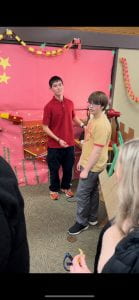Welcome back to my second winter exhibition. This year I knew what to expect and how to prepare for the challenges that come with exhibitions to make it easier on me and my group.
This year our topic was Revolutions. We learned a little bit about every revolution and then were aloud to choose one that we would be studying for the rest of the project. I chose to study the Xinhai Revolution, because that is one that I thought was very interesting and I knew it would keep me interested and engaged for the rest of the project.
We learned about our revolutions for a few weeks so that we knew 100% of it. Our final product for this project was a Rube Goldberg machine, with the connections from the different parts of the machine representing different, significant parts the revolution. Knowing this, we all understood that we had to know this revolution incredibly well so that the connections would be accurate and understandable. Throughout the process of learning about revolution we were put into our groups of everybody studying the Xinhai Revolution to discuss what we had learned, and compare our notes. I think that this was a very crucial to our understanding because seven minds work better than just one.

Over the next few weeks after the research process we got together as our Xinhai group every day to start making the connections for our machine. This was helpful because it gave us time to get used to working together with each other before the actual building process. It was important to us as a group to be on the same page at all times, because when even one of us is not on the same page as the rest if the group, or not on task it could set us back quite a bit. While planning we were assigned roles which would help guide us when we were lost and keep us busy. I was given the role of Engineering/Physics expert. This meant that I had the job of making sure everything would work, and deciding what to add and or take away to make the machine run better.
When it actually came to building the machine, there were a few challenges. One of the challenges was being precise. This was a problem because we had to transfer exactly what was on our blueprint into real life with the materials we were given. One of the solutions for this we found, was trial and error. We would test one part of the machine over and over until we got the exact angle or exact length and then we would attach it to the board. This worked really well for us because it was efficient and easy to understand, so that everybody in our group could help. Another problem we had was finding enough jobs for all of us to do. This was a problem because the jobs we were assigned often didn’t transfer into the actual building, but instead helped with the earlier steps focussed on preparation. I think that I was good at finding work and when I didn’t have any work I would ask our project manager. A few times though, not everybody in our group did this and I would often find myself with a sidekick that wouldn’t do as much as they could, and instead just followed us around not being productive. This was probably our biggest challenge as a group, however we almost always helped each other and reminded them what there task was, and how to be productive with our time.

On the day of the actual exhibition we were all very excited and nervous, partly because I think we poured so much hard work into these machines, partly because we didn’t know if they would work. At this point we were down two team members due to time conflicts, but it was ok since we had adapted our script to fit just the five of us. As people watched us, we explained our machine, why each connection was important to the revolution, then showed them the machine in action. It almost always went well, and the few times it didn’t we swiftly got it working agin and tried again. When I look back on the night I think that we did a really great job working together and staying positive, while also sticking to the plan.
Our Driving question for this project was, How do Ideas Drive Change? I think that ideas spark change by questioning the status quo and inspiring new possibilities. When embraced and put into action, new ideas have the potential to shape movements and drive progress. In short, ideas serve as the driving force behind new transformative change for the better of our race.
Overall, I think that this exhibition wen much better than intimidate. I really enjoyed working with the people in my group, and would happily do it all over again. I think that the biggest things I learned this project where, teamwork, and patience. Without everybody in my team doing these two essential things, I think that this project would have not been as successful as it was.
